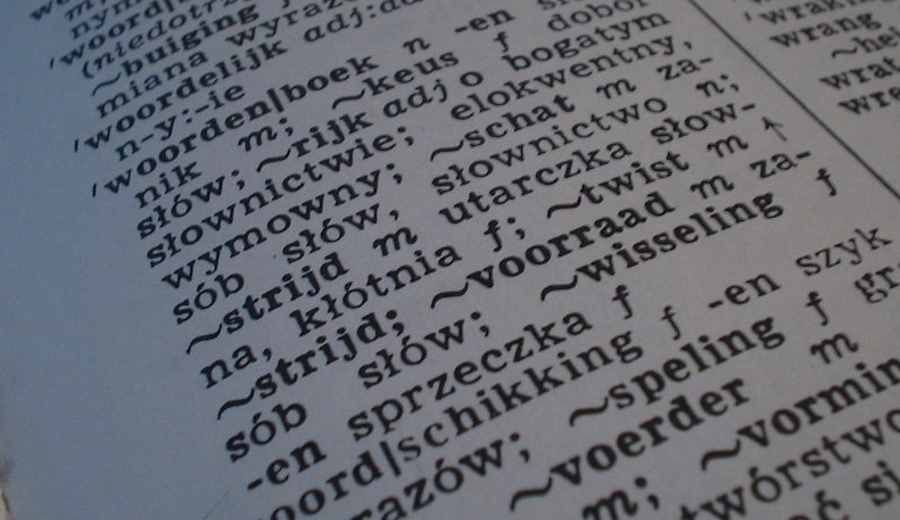Polish language in the era of 140 characters, memes and instastories
According to UNESCO, more than half of the world’s 6,500 languages are in danger of being forgotten. Since 1950 alone, 250 languages have disappeared, and with them cultural and intellectual wealth. International Mother Language Day, celebrated on February 21, is intended to draw attention to the problem of disappearing linguistic diversity and to help protect it.
According to estimates, by the end of this century, there will be about one-tenth of the languages currently in use leftow. A less pessimistic scenario assumes that by the end of the 21st century we will be using about half of them. To protect the roUNESCO in 1999 established the International Day of the Mother Tongue.
Currently, the most widely spoken languages are Mandarin – used by 1170 million osob, English – it is used by 1135 million peopleob, Spanish – used by 450 million peopleob, Hindi has 400 millionoin the useroin and Arabic, with whichohe language is used by approx. 350 million osob. More than 6,500 languages are currently in useow, but historians estimate that throughout history mankind has spoken 13,000 languagesow.
"Books are like company, whichore man chooses"
It is no secret that we treat reading as an automated activity – A simple perception test is enough to prove that it takes us less time to read letters and form a word from them than to extract from memory the name of a color, ktorym have been written down, and whichory is not the same as the description of the. In the age of medioIn social media, we are constantly decoding texts and creating more messages. We communicate much more often by writing than mow, often encapsulating our message in 140 characters with distinctive hashtags.
We describe, comment on, enter into discussion rarely wondering where we get the linguistic patterns we use. We do it quickly, mechanically, unreflectively. We use linguistic cripples, far-fetched skrotoin thought, we modify the language by creating neologisms that are not always understandable, and although this one is a living matter it needs to nurture its poetic form and allow it to resound in literary shape from time to time.
Where to find it? In literature. Unfortunately, according to the report – „The state of reading in Poland in 2016.”, ktory was published last April, any book was read in twelve months by only 37 percent of the. Poleoin, and only 10 percent. read 7 or more items.
Young people and books
What literature and what heroes shape the language of young Polishow? Teachers and students will carry out the so-called “holiday”. The core curriculum containing a list of compulsory and supplementary readings. OmoThey can also use these books, whichore to Polish language lessons are brought by the students themselves. The answer to the question of why, despite living in a world of textow so rarely reach for literature was given by Polish language teachers from the Social Educational Society, whichoThose who work with young people on a daily basis.
– I try to show students that you should build your unique relationship with a book. What delights some may bore others, to someone it may seem too difficult or too banal. The same reading can be graded highly by one class, and in another group discussing it goes like a dilemma – mowiTh Joanna Piechna-Chrzanowska from STO school in Warsaw’s Bemowo district.
Polish teachers emphasize that the closest to the heart of a young reader is a character whoore his life is filled with strangeness, magic and fantasy. – It seems little attractive, for example. Staś Tarkowski or Tom Sawyer, and the exotic background or the unfamiliar but realistic world presented in the novel cannot change this. Other countries, continents, nature, culture – This is what today’s young readers often experience on their own, during vacations with their families. What intrigues him, arouses his curiosity and stirs his emotions – is a surprisingly otherworldly, alien world and a hero who combines human sensibilities (and yet!) and opportunities and supernatural skills. When we add to this a pinch of modern technology and the traditional theme of the struggle between good and evil, we gain the interest of most studentsow – explains Katarzyna Ziołkowska from ZSO STO No. 1 in Warsaw.
Not surprisingly, a lot of enthusiasm is aroused by the "Lord of the Lion" D. Terakowska, "The Hobbit" J. R. R. Tolkien’s or "Baśniobor" B. Mulla. For many years, the greatest popularity has been and continues to be enjoyed by – literature wspoContemporary, however, students are increasingly and strongly forming their tastes based on recommendations found online.
– Much is dictated by the book market and advertising wokoł it. Young people are more likely to reach for works, whichore appear in social media, about whichorych is "aloud". That’s why they are more likely to read works by wspomodern, new. However, this does not exclude the possibility of a student’s interest in books "older". And this is where the literary hero comes in. In my experience, and probably that of many other teachers, I can confidently say that the student is looking for in a book (but roalso e.g. film) characters thatore in some wayob are close to him. Class IV students are more eager to read "Diary of a Crafty", and a 15-year-old is sooner to reach for a "Catcher in the Rye" – emphasizes Paulina Richter from ZSS STO No. 7 in Krakow.
For what purpose do we reach for books? Most often, regardless of age, we look for emotions, adventuresod and heroow, with ktors we can identify with to some extent. Nonetheless, books for a student are often only reading from the so-called “book”. canon.
– The canon of school readings is based on writers like Sienkiewicz, Mickiewicz, Żeromski etc. Each of the studentsow intuitively feels a distance from them, from their worksow. It’s not surprising, because even in high school classes it’s hard to beat the "wall” many years of interpretation, historical and literary setting. And here is where teachers face the biggest challenge: to involve studentsow, without paralyzing them with the enormity of the genius of our writers, and at the same time releasing in them a fresh perspective on the epochal literature. How to do it? Despite appearances, it is not so difficult – emphasizes Paulina Richter.
Teachers have a full range of possibilities: from varied methods of activating studentsoin and the materialoin didactic, to rohe variety of events in many cultural centers including libraries or museums. In social media there are many groups where Polish language teachers exchange tworic ideas for discussing readings. In addition, students should notow limit in reading. For the polonistow the most important thing is that they read.
– My favorite sentence, ktore I repeat to the students is: "Read, because it is the most important! Read everything you feel like, but remember: you should always consider whether the workor you like or dislike and be able to answer: why? Because the greatest harm that can be done to a book is mindless reading and indifference. You will like? Great! But you also need to be able to dislike" – Paulina Richter points out.
That’s why Polish language teachers are expanding the reading list to include songs, whoothat students themselves would like to share with others. They create presentations, projects, motie about what interests them, what moved them. We wspoThe modern school’s ability to think independently, especiallyolnie in reading, should be cultivated.
Reading and the network society
The world is changing, the students are changing as well. In the era of 140 markoin, memoin and instastories change is roAlso the very process of reading, and thus thinking about literature. Because students have trouble developing their thoughts, they write skrotowo. This results in an alarming number of mistakesoin linguistic. There is a lack of reflection on the language, on the content. However, they are sometimes very creative for that! The most popular word of 2017 was „xD”.
– Young people have always liked to communicate in language „colloquial”. In the age of the smartphoneow, computerow, tabletoin the above sign is one of them. It is important that the teacher „kept up” following their fashion… – explains STO polonist from Szczecin Irena Warcok.
Marta Brus-Lapinska of STO No. 9 Warsaw adds:
– Language has always tended toward simplification, and I do not consider this a negative phenomenon. My only concern is that with the simplification of language, the perception of the world is also simplified. The range of recognizable emotions is diminishing, the color palette is fading, the nature around us is merging into a homogeneous mass. Attentiveness in noticing nuance is decliningow, because there is a lack of wordsoin, to name them. It is worth taking this opportunity to ask what the next major educational reform changes or brings?
In response, we hear rather bitter words:
– Wspoln common, my colleagues and I feel uneasy about theoj and frustration with the rigid demands of reform. Until now, we have had the impression that we are trusted, and our job is to show students how to reach rohe variety of information, how to select and value it. We have the impression that the freedom of action has been taken away from us. The emphasis is definitely on knowing, not on knowing how to – mowi Jadwiga Kurzydłowska from SSP STO No. 1 in Szczecin.
Teachers have already become accustomed to constant changes in the educational system, so they persist in it with the knowledge that probably soon another change will come and znoin there will be proposals for corrections. Dariusz Dybek from ZSO STO in Kluczbork has no doubts about such a turn of events:
– To me, it looks like a somewhat fatalistic approach to what they propose to you „na gorze”, according to the wordsoIn the era of the smartphone, the songs of Wojciech Mlynarski: „Robmy our…”.
Sourceosource: Social Educational Society, PAP, photo. CC-BY-SA-2.5/ Michiel1972/ Wikimedia Commons


